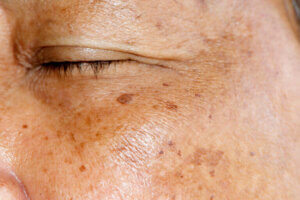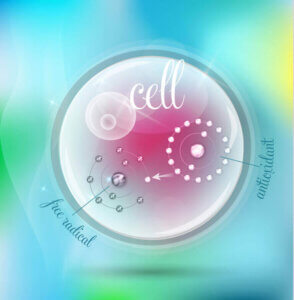Your skin has many ways of telling you it’s getting older (most of them unwelcome).
Wrinkles may start to appear. The area under your eyes may look dark and puffy. Certain areas of skin become a darker color.
This last sign of aging is a very common one. It goes by many names— dark spots, age spots, sunspots, liver spots— and is often frustrating to deal with. You might be wondering why areas of your skin suddenly appear darker and how to get them back to normal.
Though tricky to deal with, dark spots don’t have to be the end of the world.
Here’s more about how and why they form and what you can do about them, including natural solutions that don’t involve applying toxic chemicals to your skin.
Where Do Dark Spots Come From?
The technical term for dark spots on your skin is hyperpigmentation. This simply means that specific areas of skin have more pigment than others, which makes them appear darker.
Now, hyperpigmentation can occur for several reasons.
For example, melasma is a skin condition characterized by brown or grayish patches of skin. It usually affects the face and appears most frequently in pregnant women. The exact cause of melasma isn’t known, but it’s thought that hormonal changes are the main culprit.
Dark reddish spots left by acne and other inflammatory skin disorders are another example of hyperpigmentation.
Of course, the most common type of hyperpigmentation is the dark spots that are a sign of aging. They appear because of an overproduction of melanin, the same substance that colors your skin and gives you a tan. But unlike a tan, these spots of melanin do not fade, leaving you with darkened areas of skin year round.
What Causes Dark Spots to Form?

The main cause of dark spot formation is excessive sun exposure. Sunlight is by no means “bad” for you, and your skin needs a certain amount of exposure to it to produce vitamin D. However, too much exposure to the UV rays from sunlight can do major damage to your skin.
Frequently getting sunburned is one sign that you are damaging your complexion, but your skin doesn’t have to burn to get damaged.
Essentially, UV rays from the sun can penetrate unprotected skin and cause DNA changes at the cellular level. This is known as photodamage or photoaging and happens in the deepest layers of your skin. Because the damage done is so deep, visible effects may not appear for years.
Unfortunately, when the effects of UV damage do emerge, your skin can start looking older quite rapidly.
You’ll notice the dreaded dark spots appearing as well as other signs of aging like wrinkles, fine lines, and roughness. Dark spots usually appear on the face first and later on the hands. However, you may develop them on any area of skin that gets exposed to sunlight.
It’s also important to note that while paler complexions are more susceptible to photodamage, hyperpigmentation can affect any skin color and tone and may be more noticeable on darker skin.
The Challenge of Combating Hyperpigmentation & Dark Spots
First, let’s start with some good news: It is by no means impossible to fade the appearance of dark spots. There are some great options out there for combating hyperpigmentation, including natural ones that won’t damage your skin.
However, you should also be aware that there is no overnight fix— and it can be a frustrating process.
Remember, dark spots are like a “surface sign” of damage that has already happened much deeper within your skin. Because this damage reaches all the way to the cellular level, you need something more powerful than a surface treatment.
This also means that the rejuvenation process will seem slow at first. To really change how your skin looks, skincare ingredients have to work at the cellular level where the damage first occurred. You won’t be able to see this work happening, but the results will show up over time.
And speaking of results, here’s some more information on the most common conventional treatments for dark spots (and their potential drawbacks) as well as top natural alternatives that are both effective and non-toxic.
Conventional Treatment for Age Spots
Topical OTC or Prescription Treatments

Retinoids can come in the form of an over-the-counter (OTC) retinol product or stronger prescription retinoids. No matter what form they take, all retinoids are a typically synthetic derivative of vitamin A. They work at the cellular level, which is part of what makes them effective, and can help fade the appearance of dark spots.
Hydroquinone works differently. It’s basically a skin-bleaching substance that works by decreasing the number of melanocytes present in your skin. (Melanocytes produce melanin.) This lightens skin, including darkened areas.
Potential Downsides: Both retinoids and hydroquinone can be harsh on sensitive skin. Retinol, especially, is known to cause redness, dryness, and irritation. There’s also indication that retinoids may make your skin more sensitive to sunlight, which could mean more signs of aging down the road (the opposite of what you want).
Hydroquinone may worsen hyperpigmentation if you have a darker skin tone because of its bleaching effect. It can also cause a condition known as ochronosis in which bluish-black patches appear on your skin.
Chemical Peels & Dermabrasion
Another way to attempt to combat dark spots is to get rid of the top layers of skin where most of the pigment is found and allow new skin cells to regenerate in their place.
Chemical peels, unsurprisingly, do this by applying a chemical solution to your skin. There are different levels of a chemical peel (light, medium, and deep) and different chemicals that can be used (glycolic acid, lactic acid, salicylic acid, carbolic acid, etc.).
Dermabrasion uses physical rather than chemical means. It essentially sands down your skin to get rid of the top layers and allow new skin to grow in their place. Microdermabrasion is gentler on skin but has more modest results.
Potential Downsides: Again, both of these methods are fairly harsh on your skin and can leave it red, irritated, and sensitive. New skin is more likely to be damaged by UV rays than older skin, so you’ll also have to be extra careful in the sun.
Chemical peels may contain toxins, including cancer-causing chemicals. Deeper peels even require you to take medication for 10-14 days afterwards to avoid infection.
Finally, there is a chance that both a chemical peel and dermabrasion can cause scarring or worsen hyperpigmentation. If you are prone to scarring or have a naturally dark skin tone, you may want to look into other options.
Cryotherapy

Cryotherapy uses liquid nitrogen (or another freezing agent) to target dark spots. Usually, your skin is only exposed to the freezing agent for seconds, but this is enough to help destroy extra pigment and cause the top layer of skin to peel away. It should come back lighter when it heals.
Potential Downsides: Pain, redness, and swelling are all temporary side effects of cryotherapy. Though not common, your skin can permanently scar or become discolored where it was frozen.
Laser Treatments
Relatively new, laser treatments are another way to get rid of melanocytes (melanin-producing cells) and remove the top layer of skin. There are different types of laser treatments and each helps fade dark spots in a slightly different way. Generally, your skin should heal back brighter.
Potential Downsides: The biggest drawback for many is that laser treatments are relatively expensive. Most of them do wound your skin, so you can expect irritation and redness after treatment (sometimes for months). Those with darker skin tones are at risk for hyperpigmentation worsening after treatment.
Natural Alternatives for Fading (and Preventing) the Appearance of Dark Spots
If you don’t want to apply toxic chemicals to your skin or treat it harshly, can you still diminish age spots?
The short answer is yes, you absolutely can, but it will take a few months to see results. Below are the top natural ways to address dark spots with research to back them up. Be patient and consistent with them, and you’ll be pleased with the results!
Sun Protection

Before we get into dealing with existing age spots, it’s important to talk about prevention. The dark spots you see now came from damage done years ago, so it’s time to start thinking about how you want your skin to look years from now.
Without a doubt, the most effective step you can take is to protect your skin from excessive sun exposure.
This doesn’t mean your skin should get zero sun exposure. As mentioned earlier, some sun (without sunblock) is needed for adequate vitamin D production.
Consume & Apply Vitamin C
Vitamin C is one of the most effective natural ingredients for diminishing the appearance of dark spots. It has natural skin-brightening properties and also helps to calm the look of redness and inflammation, evening out your skin tone.
So how does it work for hyperpigmentation?
Research has shown that vitamin C decreases melanin formation, which in turn decreases pigmentation in your skin. This has the effect of making dark spots look less noticeable and can fade their appearance when applied to your skin over a period of time.
In addition, vitamin C has photoprotective properties, which means it may help prevent more dark spots from appearing on your skin (wrinkles, too).
Applying vitamin C to your skin is the most powerful way to combat dark spots. However, your body also needs this essential vitamin for overall skin health and photoprotection, so consuming it is great as well.
You’re probably already familiar with top vitamin C foods: citrus, mangoes, colored bell peppers, kiwi, pineapple, papaya, and so on. Some of the best vitamin C ingredients in skincare products to look for include camu camu, Indian gooseberry, rosehip seed oil, acai, and mango butter.
“Feed” Your Skin Antioxidants

Antioxidants are one of the best anti-aging skincare ingredients you can be “feeding” your skin. They work deep at the cellular level (exactly where photodamage happens) to repair and rejuvenate skin cells.
The main way antioxidants work is by combating free radical damage. This is important because excessive UV exposure does its damage to your skin in part by the generation of free radicals. These free radicals react destructively with important skin proteins and lipids and even degrade collagen.
The good news is that antioxidants combat dark spots in two ways.
By neutralizing free radicals and offering photoprotection, they can help to interrupt melanin formation and prevent dark spots from forming. In addition, studies are showing that antioxidants have a lot of potential for fading the appearance of existing hyperpigmentation.
Vitamin C, by the way, is an antioxidant in its own right. Other top antioxidant ingredients to look for include sumac berry, turkey tail mushroom extract, astaxanthin, green tea, and bakuchiol.
Hydrate with Aloe Vera
Aloe vera is truly an amazing plant. The succulent leaves contain over 130 different plant compounds as well as trace amounts of numerous vitamins and minerals. They also boost skin hydration due to the presence of mucopolysaccharides that help bind moisture to your skin.
You likely already know that aloe can help your skin to recover after a burn or sunburn. It has even shown protective effects against UV damage, but that’s still not its best property when it comes to dark spots on your skin.
Aloe vera contains active ingredients known as aloin and aloesin. Researchers have found that both aloin and aloesin have melanin-inhibiting properties and can help to lessen hyperpigmentation. In addition, another study revealed that aloesin may also help prevent dark spots from forming.
To get the power of aloe, you can simply apply the pure gel to pigmented areas every night. Or for more effectiveness, look for a skincare product that combines aloe vera with vitamin C and antioxidant ingredients.

Try it today with a 60-Day Money
Back Guarantee!



